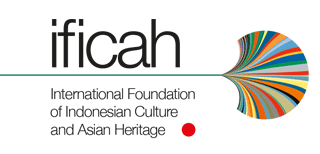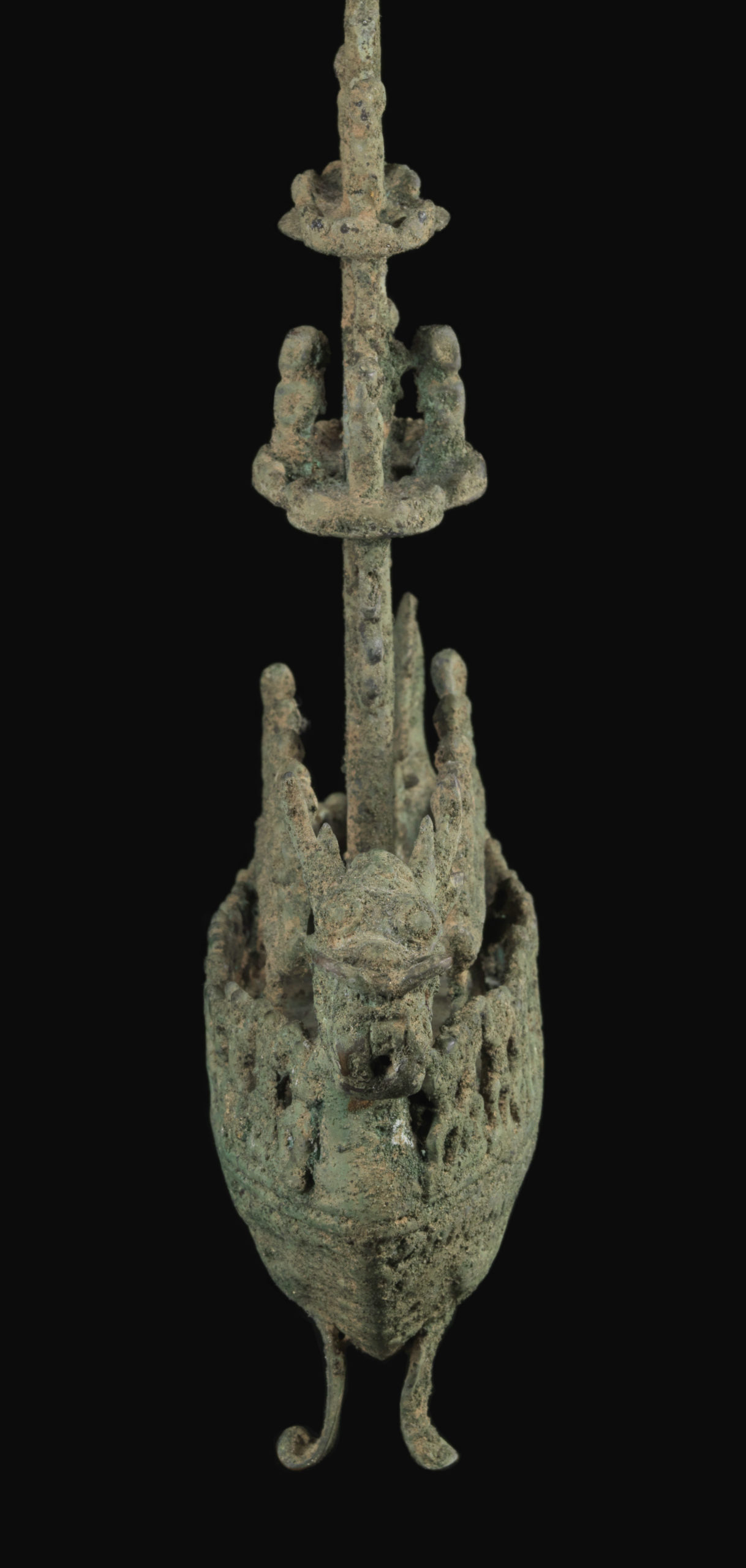Ancestral ship
This bronze votive boat was not found on Luzon, but on Mindanao in the southern Philippines. Nevertheless, it was included in this exhibition because it vividly depicts the cosmology and symbolic world order of the Austronesian ethnic groups, on which the social order is also based. Southeast Asian communities often symbolise their cohesion within the vertical world order in world planes through ships.
The shown object represents a dragon being whose body has the shape of a boat. The hull of the boat-shaped body has legs that make it possible to stand or present it on a flat surface. In the middle of the deck a mast is placed, to which two platforms are attached, one above the other. These can be platforms for archers or the viewing platform (“lookout”) common on ocean-going ships. On deck, two longitudinal elements are visible which cannot be identified with certainty. They may be rudder bearings, paddle benches or protective devices on a warship. The edge of the boat and the double lookout platform are lined by a row of standing human figures with raised arms. These are deprived of any individuality and look almost like silhouette figures. On the two bar-like elements on the deck, a series of figures can be seen in a squatting position. Further squatting figures are placed on the “lookout platforms” or shooting platforms. The figures on the edge form an amorphous row, which is closed by the raised, interconnected hands. The platforms on the mast are supported on the mast by stylised groups of snakes.
The design elements of the boat show typical features of East Javanese bronze art. In East Java, during the Majapahit period (1292 A.D. to the beginning of the 16th century), bronze casting in lost form was developed into a previously unseen spectrum of forms and motifs. Especially remarkable is the expressive dragon head with the oversized bleached teeth. The headdress of the dragon with the horn-like extensions is clearly in the tradition of Chinese dragon depictions. The raised flews are a stylistic element that can be found on East Javanese bronzes on animal and mythical creature heads and is strongly influenced by Tamil stylistic features. The detail of the snake shapes supporting the platforms can also be associated with East Javanese bronzes (“Flames of Power”, modang), which show magically powerful beings. A dominant figure cannot be identified – except for the dragon itself. The boat as a whole does not seem to indicate a function of its own. There is no roofing or other kind of deck construction to be seen, as is otherwise known from contemporary ship depictions or funeral boats. From a technical point of view, the boat can therefore not be regarded as a funeral ship but as a symbolic object, since there is no device for laying out or transporting the deceased.
The triple staggering of the deck with the platforms can be understood as a reference to the cosmological division into world levels common in South East Asia, whereby the upper level – that of the ancestors and gods – is often still divided into several levels. The high-ranking ancestors are located at the highest level. The squatting figures on the higher levels embody ancestors. Explicit representations of ancestors have been largely superseded by Hindu-Buddhist and Muslim influences in Java, Sumatra and Mindanao. The drawn-up knees refer to ancient burial rites in which the deceased is put back into the position of an embryo.
The boat can be regarded as a votive offering of East Javanese provenance, which was intended for export to a province of the Majapahit Empire “for barbarian taste”.
The ship is a junk of Chinese-Javanese design. Philippine bangka and East Indonesian boat forms have an outrigger and do not seem to have been the inspiration for the design of this object. With its figural programme it embodies the cosmological idea of East Indonesian ethnic groups with the dragon or the dragon snake as the carrier of the world. The object as a whole is the representation of a village, a village community under the protection of the naga, the local protective spirit. Through the dances the village community evokes its mythical common agreement, embodied by the boat and the naga. On the lower level, the living people dancing around the axis mundi are depicted, grouped around the village pole, i.e. the world tree, and revive the primeval world events in the dance. Above them, staggered in planes, the ancestors crouch, who are elevated in the afterlife during the festivals where such precious possessions as the ship were presented. Ships of this kind are on display in the tradition of Bronze Age votive objects, which have been widely used in Indonesia since the Dong Son period (400 B.C.) and have been passed down through the generations. They are clan property. In the Eastern Javanese period, such objects were passed on to the provinces as gifts and consecrated gifts by Singgasari and Majapahit.
| Objekt | Votive ship, ancestral ship |
| Kultur | Java (?), found in the Philippines 1970 |
| Zeit |
13th – 15th century |
| Maße | Height 39 cm, Width 31 cm |
| Material |
Bronze ( cast in lost form ) |











